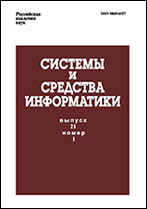|
This article is cited in 1 scientific paper (total in 1 paper)
Truncation bounds for a class of inhomogeneous birth and death queueing models with additional transitions
A. I. Zeifmanabc, A. V. Korotyshevaa, Ya. A. Satina, K. M. Kiselevada, R. V. Razumchikdc, V. Yu. Korolevec, S. Ya. Shorginc
a Vologda State University, 15 Lenin Str., Vologda 160000, Russian Federation
b ISEDT RAS, 56-A Gorky Str., Vologda 160001,
Russian Federation
c Institute of Informatics Problems, Federal Research Center "Computer Science and Control" of the Russian Academy of Sciences, 44-2 Vavilov Str., Moscow, 119333, Russian Federation
d Peoples' Friendship University of Russia (RUDN University),
6 Miklukho-Maklaya Str., Moscow 117198, Russian Federation
e Faculty of Computational Mathematics and Cybernetics,
M.V. Lomonosov Moscow State University, 1-52 Leninskiye Gory, GSP-1, Moscow 119991, Russian Federation
Abstract:
The paper considers the computation of limiting characteristics for a class of inhomogeneous birth-death processes with possible transitions from and to origin. The authors study the general situation of the slower (nonexponential) decreasing of intensities of transitions from state $0$ to state $k$ as $k \to \infty$. The authors consider the situation of weak ergodicity and obtain bounds on the rate of convergence in weighted norm and, moreover, uniform in time bounds on the rate of approximations by truncated processes. The inhomogeneous $M/M/S$ queueing model with additional transitions is studied as an example.
Keywords:
inhomogeneous process; birth-death process; approximations; truncations; ergodicity; bounds; queueing systems.
Received: 30.06.2017
Citation:
A. I. Zeifman, A. V. Korotysheva, Ya. A. Satin, K. M. Kiseleva, R. V. Razumchik, V. Yu. Korolev, S. Ya. Shorgin, “Truncation bounds for a class of inhomogeneous birth and death queueing models with additional transitions”, Sistemy i Sredstva Inform., 27:3 (2017), 37–51
Linking options:
https://www.mathnet.ru/eng/ssi527 https://www.mathnet.ru/eng/ssi/v27/i3/p37
|

| Statistics & downloads: |
| Abstract page: | 337 | | Full-text PDF : | 140 | | References: | 43 |
|



 Contact us:
Contact us: Terms of Use
Terms of Use
 Registration to the website
Registration to the website Logotypes
Logotypes